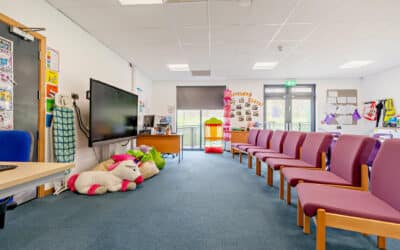TG Escapes Blog
SCHOOL MYOPIA: A SILENT EPIDEMIC – Why Natural Light and Time Outdoors Can Help
Over the last 30 years short sightedness, or myopia, has become a global health problem. For example, nearly every child now leaving secondary school in Singapore, Hong Kong, Taiwan and elsewhere in East Asia needs glasses or contact lenses to see clearly. Ten per cent, or more, are severely myopic and so are at high risk of losing their sight. And we are catching up with East Asia.
Since the 1960s, the incidence of myopia has doubled in Europe and the United States. It is estimated that by 2050 half the world’s population, some 5 billion people, will be short-sighted. Roughly 1.5 billion people are today. Also, the age at which children are becoming short-sighted is falling. This is most unfortunate because the earlier a child becomes myopic the more rapidly the condition progresses and the more severe it will get.
What is Myopia?
Myopia is the result of abnormal lengthening of the eyeball which makes light focus in front of the retina rather than onto it. Milder forms are referred to as `school' or `simple' myopia. Any level of it, whether mild, moderate or severe, significantly increases the risk of developing sight-threatening conditions such as cataract, retinal detachment, glaucoma, and macular degeneration. There is no safe threshold; and the more severe the myopia, the greater the risk of ocular diseases becomes.
Schools and Myopia
From the end of the 19th century until the 1960s, good daylighting was widely believed to prevent myopia in children. Education departments built schools with large windows to try to stop it. Rules and building standards specified minimum daylight levels in classrooms this end. Outdoor activities were also thought to protect children’s sight. One reason for putting playgrounds and open spaces around schools was to try to prevent myopia. Also, prolonged near work, such as reading, was believed to be harmful and so was discouraged.
But then, in the 1960s, medical thinking changed radically. From this time, myopia was believed to be mostly inherited and not preventable. Daylight was no longer thought to be important for the healthy development of children's eyesight. Designing classrooms protect children’s eyesight stopped. However, recent scientific findings suggest it may be time to start again.
New Research, Old Ideas
There is no agreement on the exact cause of myopia. But new research is supporting some old ideas. One of them is that school children who spend more time outdoors have less chance of damaging their sight. The reason for this is not clear yet, but recent findings strongly suggest that daylight at levels higher than those typically found indoors help to stop children becoming short-sighted. And children who experience lower ambient light levels seem to be at greater risk of damaging their sight.
Excessive near work, such as reading, has long been thought to be harmful to children’s eyesight. Evidence for a link between this and myopia is not as strong as that for the protective effect of outdoor activity and of daylight. But research is in its early stages. The results of one study found that children with little exposure to
daylight had a fivefold risk of developing myopia. If they also performed close-up work this could increase to a 16-fold risk.
While the exact cause of myopia continues to be debated, it is clear is that every year a child spends at school significantly increases their chances of becoming short-sighted. The children at greatest risk of school myopia are in education systems that encourage highly competitive, intensive study from an early age. And they live in urban rather rural areas. Children who do not go to school are unlikely to become short-sighted; although a few may inherit the condition.
Prevention
Worldwide, myopia poses a major challenge to public health. The social and economic costs of this epidemic are becoming more widely recognised. In those countries worst affected, educational thinking is changing. There is more emphasis on outdoor activity. And, fifty years after it stopped, there is renewed interest in daylighting classrooms to protect children's eyesight. A so-called `Bright-Light’ classroom has been built China to test whether high daylight levels indoors can prevent myopia; as was once thought to be the case. Meanwhile, the huge pressure put on children to succeed in school continues unabated. East Asian countries lead the international rankings of educational performance. They also have the highest myopia rates. Other countries that try to emulate them may pay heavy price in the years ahead. And so will their children. Myopia is harmful. A lifetime of visual impairment, and the prospect of sight-threatening conditions, lie ahead for many children. To stop this we have to be prepared to change teaching methods; and the design of classrooms and schools.
References
Dolgin E. The myopia boom. Nature. 2015 Mar 19;519(7543):276-8. https://www.nature.com/news/the-myopia-boom-1.17120
Hobday R. Myopia and daylight in schools: a neglected aspect of public health? Perspectives in Public Health 2016 Jan;136(1):50-5.
Holden BA, Fricke TR, Wilson DA, et al. Global prevalence of myopia and high myopia and temporal trends from 2000 through 2050. Ophthalmology 2016 May;123(5):1036-42. http://www.aaojournal.org/article/S0161-6420%2816%2900025-7/fulltext
Lagrèze WA, Schaeffel F. Preventing myopia. Deutsches Ärzteblatt International 2017;114:575-80. https://www.aerzteblatt.de/pdf.asp?id=193156
Author: Dr. Richard Hobday is an internationally recognised authority on health in the built environment. He is currently investigating how to design schools that protect children's eyesight.
He is the author of two influential books: The Light Revolution; Health Architecture and the Sun (2007); and The Healing Sun: Sunlight and Health in the 21st Century(1999). The Healing Sun has been translated into ten languages.

About the author
More posts from our blog
TG Escapes partner with Class of Your Own’s ‘Adopt a School’ Scheme
We're thrilled to announce a landmark collaboration between Stratford upon Avon School, a beacon of the Design Engineer Construct! (DEC) Learning Programme, and TG Escapes. This partnership fostered through Class of Your Own’s 'Adopt A School' scheme, marks a...
Student engagement day at Beacon Hill School
Two members of the team recently had the privilege of showing students and staff around our latest project nearing completion, at Beacon Hill School in Wallsend. The school is North Tyneside’s specialist provision for children with severe learning difficulties that...
The Design Essentials of a Modern SEND Classroom
There is a desperate need for quality new buildings across UK schools, but special schools are in a particular crisis thanks to rising needs and inadequate funding, with an urgent need for buildings that offer children with complex needs a comfortable and safe space...



